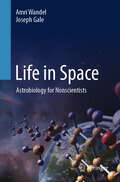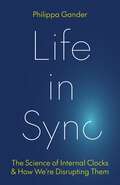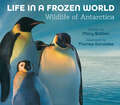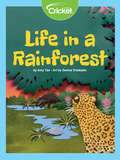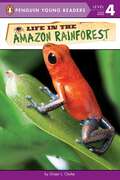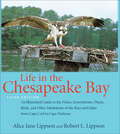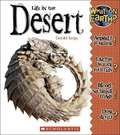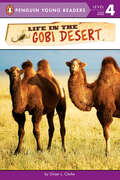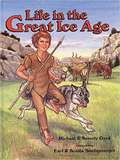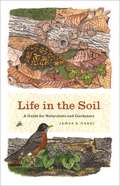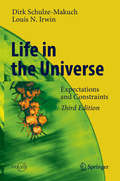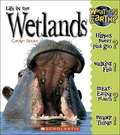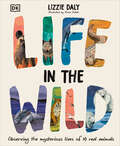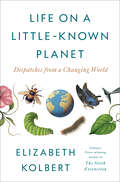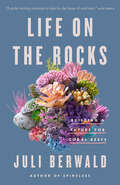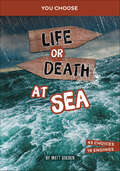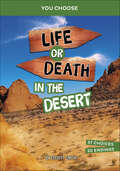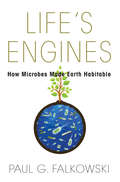- Table View
- List View
Life in Space: Astrobiology for Nonscientists
by Amri Wandel Joseph GaleOver the last two decades alone, new technology and space missions have profoundly changed our understanding of prospective extraterrestrial life in the universe. The resulting field of astrobiology has become a highly eclectic and interdisciplinary pursuit, encompassing many of the natural sciences and holding ramifications for nearly all other areas of study. Co-written by an astrophysicist and a biologist, this introductory undergraduate textbook presents an overview of astrobiology for students from all backgrounds. Addressed in its chapters are the recent detection of potentially habitable planets and the prospects for detecting biosignatures and life; the celestial and geological factors that enabled the appearance and evolution of life on Earth; and other factors that continue to affect life up to the present, such as climate change. Based on over twenty years of university coursework, and in particular the authors’ own interdisciplinary astrobiology curriculum, the text is accessible not just for the budding science major, but for any undergraduate student or lay reader excited by the prospect of life in the universe.
Life in Sync: The Science of Internal Clocks and How We’re Disrupting Them
by Philippa GanderWhy we need to reconnect with nature&’s biological rhythms—and rediscover the benefits of a good night&’s sleepAll of life is profoundly shaped by the daily, monthly, and yearly cycles of our planet, and all creatures have internal timekeeping systems that rely on cues from the surrounding environment. With modern technology, we are changing our environments—and by proxy, the ecosystems around us—to override these innate rhythms of life. But at what cost? Life in Sync reveals how Earth&’s rotations shape our biology, what human sleep cycles looked like before the advent of artificial light, and why technology can&’t free us from the constraints of our circadian clocks.Philippa Gander explores the science behind the biological rhythms that animate us and our world, blending captivating storytelling with illuminating examples ranging from migratory birds and hibernating squirrels to jet-lagged pilots and astronauts in space. She shows how genetic circadian clocks are an ancient evolutionary adaptation that we share with all life on the planet, and how our rapidly expanding use of artificial light at night disrupts the time cues for entire ecosystems. Gander explains why cutting back on sleep adversely affects our well-being, safety, and longevity, and how breakthroughs in sleep science offer solutions to bring our lives more in harmony with nature&’s rhythms.An astonishing journey of scientific discovery, Life in Sync unlocks the mysteries of biological time—and offers new perspectives for anyone who has ever given up a good night&’s sleep for the sake of their hectic waking hours.
Life in a Frozen World: Wildlife of Antarctica
by Mary BattenAntarctica is one of the most extreme environments on Earth—the coldest, windiest, driest place on the planet. This frozen continent affects weather, ocean currents, and sea levels all over the Earth.From award-winning, experienced nature writer Mary Batten comes a remarkable nonfiction picture book that plumbs the mysteries of this hostile environment. With clear, engaging language, Batten explores fascinating questions that scientists the world over have been researching, such as how a wide variety of wildlife can survive in this frigid environment and how Antarctica might be the key to long-standing questions about the Earth and climate change.New York Times bestselling illustrator Thomas Gonzalez brings Batten's text to life with detailed, realistic paintings. An ideal resource for young science lovers and educators, this informative volume is perfect for classroom units on climate change, conservation, ecology, oceanography, and more.
Life in a Rainforest
by Amy TaoDo you know how many animals live in the Amazonian rainforest? Learn about the different predators and prey that coexist and depend on one another to survive in their ecosystem.
Life in the Amazon Rainforest (Penguin Young Readers, Level 4)
by Ginjer L. ClarkeJourney through the jungle in this fact-packed leveled reader!Welcome to the largest rainforest in the world, a vast wonder just waiting for you to explore. Follow along as pink dolphins dart through the flooded river, vampire bats swoop down from the trees, and giant green anacondas slowly slither across the forest floor. This humongous habitat is home to millions of plants, animals, and people. But large as it may be, the Amazon Rainforest is in danger--and shrinking fast. Learn more about this amazing place and discover what you can do to help save the rainforest!
Life in the Chesapeake Bay
by Alice Jane Lippson Robert L. LippsonLife in the Chesapeake Bay is the most important book ever published on America's largest estuary. Since publication of the first edition in 1984, tens of thousands of naturalists, boaters, fishermen, and conservationists have relied on the book's descriptions of the Bay's plants, animals, and diverse habitats. Superbly illustrated and clearly written, this acclaimed guide describes hundreds of plants and animals and their habitats, from diamondback terrapins to blue crabs to hornshell snails.Now in its third edition, the book has been updated with a new gallery of thirty-nine color photographs and dozens of new species descriptions and illustrations. The new edition retains the charm of an engaging classic while adding a decade of new research.This classic guide to the plants and animals of the Chesapeake Bay will appeal to a variety of readers—year-round residents and summer vacationers, professional biologists and amateur scientists, conservationists and sportsmen.
Life in the Chesapeake Bay: An Illustrated Guide to the Fishes, Invertebrates, Plants, Birds, and Other Inhabitants of the Bays and Inlets from Cape Cod to Cape Hatteras
by Alice Jane Lippson Robert L. Lippson“The best-written and best-illustrated guide ever about a North American tidal estuary. It is the model for all future coastal nature guides.” —Whole Earth Review Life in the Chesapeake Bay is the most important book ever published on America’s largest estuary. Since publication of the first edition in 1984, tens of thousands of naturalists, boaters, fishermen, and conservationists have relied on the book’s descriptions of the Bay’s plants, animals, and diverse habitats. Superbly illustrated and clearly written, this acclaimed guide describes hundreds of plants and animals and their habitats, from diamondback terrapins to blue crabs to hornshell snails.Now in its third edition, the book has been updated with a new gallery of thirty-nine color photographs and dozens of new species descriptions and illustrations. The new edition retains the charm of an engaging classic while adding a decade of new research.This classic guide to the plants and animals of the Chesapeake Bay will appeal to a variety of readers—year-round residents and summer vacationers, professional biologists and amateur scientists, conservationists and sportsmen.“Handsome, generously illustrated . . . All of the Bay’s richness is catalogued here.” —The Washington Post Book World“A story book, a field guide and a reference work, and anyone interested in fishing, ecology, or our bay should own it.” —The Baltimore Sun“The region’s quintessential field and reference guide.” —Chesapeake Life Magazine“One of the most popular, well written, and useful guides to the Chesapeake.” —Northeastern Naturalist
Life in the Desert (What on Earth?)
by Gerald LeggEarth is a wonderous planet--and What on Earth? will explore each and every facet of the planet in a way that will delight 2nd to 4th graders, librarians and parents alike! No other series for this age takes such an in depth look at each subject covered.
Life in the Gobi Desert (Penguin Young Readers, Level 4)
by Ginjer L. ClarkeDiscover the desert in this fact-packed leveled reader!Welcome to the Gobi Desert, where you can find camels, scorpions, and even snow leopards! Explore this huge habitat and meet the many creatures that call it home. But keep an eye out for the ones that are no longer alive, too--the Gobi may have more dinosaur fossils than any other place on Earth! Learn more about this amazing place as well as how you can help protect and preserve it for future generations.
Life in the Great Ice Age
by Michael Oard Beverly Oard Earl Snellenberger Bonita SnellenbergerAfter Noah's Flood the earth and its climate were undergoing drastic changes. The stage has been set for the Great Ice Age. Noah's descendants had to learn how to survive in a strange often hostile land. In part one of Life in the Great Ice Age , we'll spend summer with Jabeth and his family as they survive a saber-toothed tiger attack, battler cave bear, and go on a woolly mammoth hunt. Part two explains the scientific reasons for the Ice Age: what caused it, and how long it lasted. It answers the question, "Will there be another Ice Age?" Archaeological and fossil finds are also discussed in detail in this exciting book that explains the Great Ice Age from a Biblical perspective.
Life in the Himalaya: An Ecosystem at Risk
by Maharaj K. PanditThe collision of the Indian and Eurasian plates 50 million years ago created the Himalaya, along with massive glaciers, intensified monsoon, turbulent rivers, and an efflorescence of ecosystems. Today, the Himalaya is at risk of catastrophic loss of life. Maharaj Pandit outlines the mountain’s past in order to map a way toward a sustainable future.
Life in the Megalopolis: Mexico City and Sao Paulo (Questioning Cities)
by Lucia SaThe modern metropolis has been called 'the symbol of our times', and life in it epitomizes, for many, modernity itself. But what to make of inherited ideas of modernity when faced with life in Mexico City and São Paulo, two of the largest metropolises in the world? Is their fractured reality, their brutal social contrasts, and the ever-escalating violence faced by their citizens just an intensification of what Engels described in the first in-depth analysis of an industrial metropolis, nineteenth century Manchester? Or have post-industrial and neo-globalized economies given rise to new forms of urban existence in the so-called developing world? Life in the Megalopolis: Mexico City and São Paulo investigates how such questions are explored in cultural productions from these two Latin American megalopolises, the focus being on literature, film popular music, and visual arts. This book combines close readings of works with a constant reference to theoretical, anthropological and social studies of these two cities, and builds on received definitions of the concept megalopolis Life in the Megalopolis is the first book to combine urban-studies theories (particularly Lefebvre, Harvey, and de Certeau) with Benjaminian cultural analyses, and theoretical discussions with close-readings of recent cultural works in various media. It is also the first book to compare Mexico City and São Paulo.
Life in the Soil: A Guide for Naturalists and Gardeners
by James B. NardiLeonardo da Vinci once mused that “we know more about the movement of celestial bodies than about the soil underfoot,” an observation that is as apt today as it was five hundred years ago. The biological world under our toes is often unexplored and unappreciated, yet it teems with life. In one square meter of earth, there lives trillions of bacteria, millions of nematodes, hundreds of thousands of mites, thousands of insects and worms, and hundreds of snails and slugs. But because of their location and size, many of these creatures are as unfamiliar and bizarre to us as anything found at the bottom of the ocean. Lavishly illustrated with nearly three hundred color illustrations and masterfully-rendered black and white drawings throughout, Life in the Soil invites naturalists and gardeners alike to dig in and discover the diverse community of creatures living in the dirt below us. Biologist and acclaimed natural history artist James B. Nardibegins with an introduction to soil ecosystems, revealing the unseen labors of underground organisms maintaining the rich fertility of the earth as they recycle nutrients between the living and mineral worlds. He then introduces readers to a dazzling array of creatures: wolf spiders with glowing red eyes, snails with 120 rows of teeth, and 10,000-year-old fungi, among others. Organized by taxon, Life in the Soil covers everything from slime molds and roundworms to woodlice and dung beetles, as well as vertebrates from salamanders to shrews. The book ultimately explores the crucial role of soil ecosystems in conserving the worlds above and below ground. A unique and illustrative introduction to the many unheralded creatures that inhabit our soils and shape our environment aboveground, Life in the Soil will inform and enrich the naturalist in all of us.
Life in the Universe: Expectations and Constraints (Springer Praxis Books)
by Dirk Schulze-Makuch Louis N. IrwinExamines each of these parameters in crucial depth and makes the argument that life forms we would recognize may be more common in our solar system than many assume. Considers exotic forms of life that would not have to rely on carbon as the basic chemical element, solar energy as the main energy source, or water as the primary solvent and the question of detecting bio- and geosignatures of such life forms, ranging from earth environments to deep space. Seeks an operational definition of life and investigate the realm of possibilities that nature offers to realize this very special state of matter. Avoids scientific jargon wherever possible to make this intrinsically interdisciplinary subject understandable to a broad range of readers.
Life in the Wetlands (What on Earth)
by Carolyn ScraceWetlands are not just muddy swamps or murky bogs! They are packed full of amazing plants and animals. Many of these would die without the food, water, and shelter that wetlands provide. Wetlands can be large or small, hot or cold.
Life in the Wild: Observing the Mysterious Lives of 10 Real Animals
by Lizzie DalyWhat can 10 real-life and uniquely jaw-dropping animal journeys teach us about our world, and the ways in which it is changing?As a filmmaker and scientist, Lizzie Daly tells stories about the natural world and uncovers the hidden secrets of our planet. But despite huge advances in technology, there is still so much we don't know about what species get up to in the wild. However, sometimes—just sometimes—we get a small glimpse into what their lives are like.This book tells the tale of our planet's intriguing wildlife. Through 10 real stories, we follow in the footprints of polar bears, big cats, wolves, and jaguars, and explore oceans with whales, sharks, and seabirds. These tales of migration, mystery, and unique behaviors teach us new and exciting information about animal activity and ecology and give us access to some of the most inhospitable corners of our planet.
Life of Inland Waters: An Elementary Text Book of Fresh-Water Biology For Students
by James G. NeedhamThis work is a textbook of fresh-water life dealing with its forms, its conditions, its fitnesses, its associations, and its economic aspects. The ecologic side of fresh-water biology is emphasized. Due consideration is given to the educational, economic, sanitary, social, civic, and aesthetic aspects of the subject.Limnology in America today is in its infancy. The value of its past achievements is just beginning to be appreciated. The benefits to come from a more intensive study of water life arc just beginning to be disclosed. That there is a widespread interest is already manifest in the large number of biological stations at which limnological work is being done.We recommend this volume as a general introduction to all students and teachers of this subject.
Life on Surtsey: Iceland's Upstart Island (Scientists in the Field Series)
by Loree Griffin BurnsOn November 14, 1963, a volcano fifteen miles off the shore of Iceland exploded under the sea, resulting in a brand-new island. Scientists immediately recognized Surtsey for what it was: an opportunity to observe the way life takes hold. Loree Griffin Burns follows entomologist Erling Ólafsson on a five-day trip to Surtsey, where since 1970 he has studied the arrival and survival of insects and other species. Readers see how demanding conditions on Surtsey can be, what it’s like to eat and work while making the smallest impact possible, and the passion driving these remarkable scientists in one of the world’s most unique fields ever!
Life on a Little-Known Planet: Dispatches from a Changing World
by Elizabeth KolbertA landmark collection of Pulitzer Prize winner Elizabeth Kolbert's most important pieces about climate change and the natural world"To be a well-informed citizen of Planet Earth," Rolling Stone has advised, "you need to read Elizabeth Kolbert." From her National Magazine Award-winning series The Climate of Man to her Pulitzer Prize-winning book The Sixth Extinction, Kolbert&’s work has shaped the way we think about the environment in the twenty-first century. Collected in Life on a Little-Known Planet are her most influential and thought-provoking essays.An intrepid reporter and a skillful translator of scientific idees, Kolbert expertly captures the wonders of nature and paints vivid portraits of the researchers and concerned citizens working to preserve them. She takes readers all around the globe, from an island in Denmark that&’s succeeded in going carbon neutral, to a community in Florida that voted to give rights to waterways, to the Greenland ice sheet, which is melting in a way that has implications for everyone. We meet a biologist who believes we can talk to whales, an entomologist racing to find rare caterpillars before they disappear, and a climatologist who&’s considered the "father of global warming," amongst other scientists at the forefront of environmental protection.The threats to our planet that Kolbert has devoted so much of her career to exposing have only grown more serious. Now is the time to deepen our understanding of the world we are in danger of losing.
Life on the Rocks: Building a Future for Coral Reefs
by Juli BerwaldThe story of the urgent fight to save coral reefs, and why it matters to us allCoral reefs are a microcosm of our planet: extraordinarily diverse, deeply interconnected, and full of wonders. When they&’re thriving, these fairy gardens hidden beneath the ocean&’s surface burst with color and life. They sustain bountiful ecosystems and protect vulnerable coasts. Corals themselves are evolutionary marvels that build elaborate limestone formations from their collective skeletons, broker symbiotic relationships with algae, and manufacture their own fluorescent sunblock. But corals across the planet are in the middle of an unprecedented die-off, beset by warming oceans, pollution, damage by humans, and a devastating pandemic.Juli Berwald fell in love with coral reefs as a marine biology student, entranced by their beauty and complexity. Alarmed by their peril, she traveled the world to discover how to prevent their loss. She met scientists and activists operating in emergency mode, doing everything they can think of to prevent coral reefs from disappearing forever. She was so amazed by the ingenuity of these last-ditch efforts that she joined in rescue missions, unexpected partnerships, and risky experiments, and helped rebuild reefs with rebar and zip ties.Life on the Rocks is an inspiring, lucid, meditative ode to the reefs and the undaunted scientists working to save them against almost impossible odds. As she also attempts to help her daughter in her struggle with mental illness, Berwald explores what it means to keep fighting a battle whose outcome is uncertain. She contemplates the inevitable grief of climate change and the beauty of small victories.
Life or Death at Sea (You Choose)
by Matt DoedenAn adventure at sea has led to disaster, and now YOU are adrift. Water surrounds you as far as the eye can see. How will you find your way back to land? What will you eat and drink? And how long can you last on your own in the ocean? It&’s time to make some difficult choices. With some smart decision making and a little luck, perhaps you&’ll be able to survive being lost at sea!
Life or Death in a Snowstorm (You Choose)
by Jessica GundersonBlinding snow and piercing wind whip at YOU. An ordinary day has turned into a life-or-death survival. How will you stay warm? Can you find shelter? And will you be able to get help before it&’s too late? It&’s time to make some difficult choices. With some smart decision making and a little luck, perhaps you&’ll be able to survive being lost in a snowstorm!
Life or Death in the Desert (You Choose)
by Elliott SmithThe sun beats down on YOU in the dry, barren desert. Somehow, you&’ve found yourself lost there. How will you find water and protect yourself from dangerous animals? And will you be able to get help before it&’s too late? It&’s time to make some difficult choices. With some smart decision making and a little luck, perhaps you&’ll be able to survive being lost in a desert!
Life's Engines: How Microbes Made Earth Habitable
by Paul G. FalkowskiFor almost four billion years, microbes had the primordial oceans all to themselves. The stewards of Earth, these organisms transformed the chemistry of our planet to make it habitable for plants, animals, and us. Life's Engines takes readers deep into the microscopic world to explore how these marvelous creatures made life on Earth possible--and how human life today would cease to exist without them.Paul Falkowski looks "under the hood" of microbes to find the engines of life, the actual working parts that do the biochemical heavy lifting for every living organism on Earth. With insight and humor, he explains how these miniature engines are built--and how they have been appropriated by and assembled like Lego sets within every creature that walks, swims, or flies. Falkowski shows how evolution works to maintain this core machinery of life, and how we and other animals are veritable conglomerations of microbes.A vibrantly entertaining book about the microbes that support our very existence, Life's Engines will inspire wonder about these elegantly complex nanomachines that have driven life since its origin. It also issues a timely warning about the dangers of tinkering with that machinery to make it more "efficient" at meeting the ever-growing demands of humans in the coming century.
